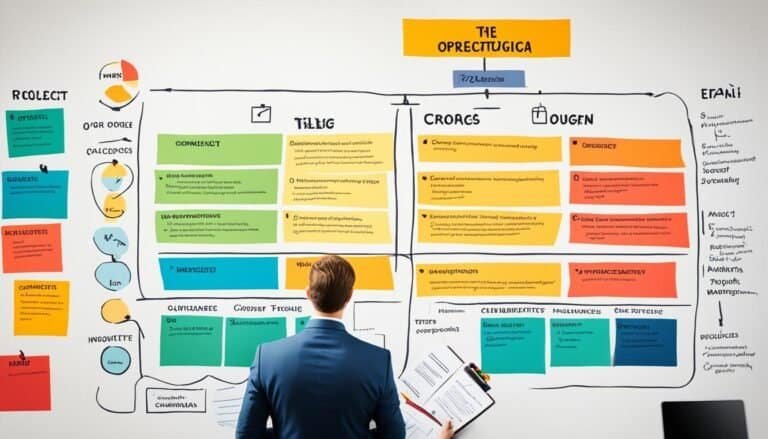Scrum for Managers: Boost Your Team’s Efficiency
Scrum is an agile framework widely used in software development. It offers an effective approach for managers to boost their team’s efficiency and deliver high-quality products. According to the State of Agile Report, almost 9 in 10 respondents leverage Scrum, highlighting its popularity and effectiveness. By implementing Scrum principles and practices, managers can drive team productivity and improve project outcomes.
In this article, we will explore various aspects of Scrum, including the Scrum process, productivity methods, enhancing team performance, measuring success, and the role of Scrum Masters. By understanding these key elements, managers can harness the power of Scrum to optimize their team’s performance and achieve their goals.
Key Takeaways:
- Scrum is an agile framework widely used in software development
- Implementing Scrum can boost team efficiency and deliver high-quality products
- Understanding the Scrum process is crucial for effective implementation
- Productivity methods in Scrum prioritize tasks and improve focus
- Scrum Masters play a vital role in enhancing team performance and removing obstacles
Understanding the Scrum Process
The Scrum process is an integral part of the agile framework, enabling teams to work efficiently and deliver high-quality products. By understanding the key components of the Scrum process, teams can effectively plan, execute, review, and improve their work.
The Scrum process consists of the following components:
- Product Backlog: A prioritized list of features, enhancements, and bug fixes that guides the team’s work. It helps the team understand what needs to be done.
- Sprint Planning: A collaborative process where the team selects items from the product backlog to include in the sprint. It also involves setting sprint goals to ensure focus and alignment.
- Sprint Execution: The phase where the team works on the selected items to deliver the planned increments. During this phase, the Scrum Master facilitates the team’s progress and removes any obstacles.
- Daily Scrum: Short, daily meetings where team members discuss progress, share updates, and plan their work for the day. It ensures transparency, alignment, and effective coordination.
- Sprint Review: A meeting held at the end of the sprint to present completed work to stakeholders and gather feedback. It helps the team validate their progress and make necessary adjustments.
- Sprint Retrospective: An opportunity for the team to reflect on the sprint and identify areas for improvement. It encourages continuous learning and enhances team performance in subsequent sprints.
Productivity Methods in Scrum
Scrum offers various methods to boost team productivity. By implementing these methods, teams can streamline their processes, improve efficiency, and deliver high-quality results. Let’s explore some of the key productivity methods in Scrum:
1. Backlog Refinement
The backlog is a prioritized list of tasks and requirements that need to be addressed. Backlog refinement involves reviewing and updating the backlog, ensuring that the most important and relevant items are given priority. This method helps the team stay focused on the most valuable work and eliminates unnecessary distractions.
2. Sprint Planning
Sprint planning is a crucial phase in Scrum. During this process, the team selects the backlog items they will work on during the sprint. This method creates clarity and defines the goals for the upcoming work period. By setting clear objectives and prioritizing tasks, the team can stay on track and maximize productivity.
3. Sprint Execution
Sprint execution involves working in short iterations called sprints, usually lasting 1-4 weeks. During the sprint, the team concentrates on the selected backlog items and strives to complete them within the agreed time frame. This method allows the team to focus on specific tasks, reducing distractions and increasing efficiency.
4. Retrospective
The retrospective is a vital part of the Scrum framework. It is a designated time for the team to reflect on their performance and identify areas for improvement. This method encourages open communication, collaboration, and continuous learning. By reflecting on their successes and challenges, the team can adapt their approach and refine their processes to enhance productivity.
“The retrospective is not only a time to reflect, but also a time to celebrate achievements and learn from mistakes.”
To further illustrate these productivity methods, here is an example of a Scrum team’s backlog refinement process:
| Backlog Item | Priority |
|---|---|
| Implement user authentication | High |
| Optimize website performance | Medium |
| Create email notification system | High |
| Fix bug in payment module | Low |
By regularly refining the backlog and ensuring tasks are sorted by priority, the team can focus on high-priority items and deliver value to stakeholders efficiently.
Incorporating these productivity methods in Scrum can help teams optimize their workflow, increase collaboration, and maximize the value they deliver. By leveraging backlog refinement, sprint planning, sprint execution, and retrospectives, teams can enhance their overall productivity and achieve greater success in their projects.
Enhancing Scrum Team Performance
Scrum Masters play a crucial role in enhancing Scrum team performance. As facilitators of the Scrum framework, they ensure transparency, promote collaboration, and advocate for continuous improvement. By leveraging their expertise, Scrum Masters empower teams to deliver high-quality products efficiently and effectively.
The key responsibilities of a Scrum Master encompass various aspects that contribute to team success. They guide the implementation of Scrum processes, ensuring that the team follows the principles and values of Scrum. Their role involves removing obstacles that hinder productivity, fostering an environment of trust and collaboration, and encouraging team members to embrace the Scrum framework.
One valuable tool used by Scrum Masters to track progress is the sprint burndown chart. This chart visually represents the amount of work remaining over the course of a sprint, providing insights into the team’s progress and highlighting potential areas for improvement. By regularly reviewing the sprint burndown chart, Scrum Masters can identify trends, address issues, and guide the team towards successful sprint completion.
Another essential element in optimizing Scrum team performance is the sprint backlog. The sprint backlog is a prioritized list of tasks that the team commits to completing during the sprint. It serves as a guide for the team’s daily activities, ensuring alignment with sprint goals and overall project objectives. Scrum Masters facilitate the creation and maintenance of the sprint backlog, working closely with the Product Owner and Development Team to ensure its accuracy and relevance.
The role of a Scrum Master goes beyond managing processes and tools. They also focus on fostering a culture of continuous improvement by encouraging regular feedback and reflection. Through retrospective meetings, Scrum Masters create opportunities for the team to identify strengths, weaknesses, and areas for growth. By facilitating these discussions and guiding the team towards actionable improvements, Scrum Masters contribute to the overall performance and success of the Scrum team.
“The Scrum Master is a servant-leader who enables collaboration, removes obstacles, and empowers the team to continuously improve and deliver value.”
By embracing the role of Scrum Masters and utilizing tools like the sprint burndown chart and sprint backlog, organizations can enhance their Scrum team’s performance. The Scrum Master’s guidance and support, coupled with a culture of transparency, collaboration, and continuous improvement, ensure that Scrum teams are equipped to deliver high-quality products and achieve project success.
Defining Team Effectiveness in Scrum
In the world of Scrum, team effectiveness transcends mere efficiency. While efficiency focuses on the quality of execution, effectiveness revolves around achieving desired outcomes. A team that operates with exceptional efficiency, delivering work at lightning speed, may still fall short if that work fails to provide value to customers. In Scrum, teams strive for effectiveness by relentlessly delivering value, seeking early feedback, and adapting their approach to align with customer desires.
Efficiency is undoubtedly important in Scrum, as it ensures that work is done well and within the allocated time. However, it is not the sole determinant of a team’s overall success. Teams must go beyond optimizing processes and outputs; they must actively prioritize delivering value to the end-user. This customer-centric mindset enables teams to create products and solutions that resonate with their intended audience.
Customer value lies at the heart of Scrum team effectiveness. It encompasses understanding the needs, desires, and pain points of customers and leveraging that knowledge to deliver impactful solutions. By focusing on delivering value, Scrum teams establish a strong foundation for building trust and fostering long-term customer relationships. Value-driven teams continuously iterate and improve their products based on customer feedback, ensuring the relevance and satisfaction of their offerings.
“Efficiency is doing things right; effectiveness is doing the right things.”
– Peter Drucker
Effectiveness in Scrum extends beyond the boundaries of individual tasks and processes. It requires a holistic approach, encompassing collaboration, adaptability, and innovation. Scrum teams actively collaborate with stakeholders, continuously seeking their input and involvement throughout the development process. This open and transparent collaboration enables teams to align their efforts with customer expectations and drive successful outcomes.
Scrum teams also exhibit adaptability, being responsive to changing requirements and market dynamics. They embrace a mindset of continuous improvement, constantly challenging current practices and exploring innovative solutions. This adaptability allows teams to remain agile and resilient, swiftly adapting their strategies to capitalize on emerging opportunities.
In summary, Scrum teams pursue effectiveness by prioritizing the delivery of value to customers. They understand that efficiency alone does not guarantee success; instead, they strive to achieve intended goals by continuously delivering value, obtaining early feedback, and adapting to customer desires. By embracing these principles, Scrum teams establish themselves as champions of customer success, driving innovation and sustainable growth.
“Effectiveness is not doing more; it’s doing the right things well.”
– Stephen R. Covey
Metrics for Improving Team Performance
In the Scrum framework, metrics play a crucial role in assessing team performance and identifying areas for improvement. By employing various Scrum metrics like velocity charts, burnup charts, and burndown charts, teams can gain valuable insights that help drive progress and achieve better outcomes.
Velocity charts are a powerful tool for measuring the amount of work completed in a sprint. They provide a visualization of the team’s performance over time, showing how much work they have been able to accomplish within each sprint. By monitoring velocity, teams can gauge their capacity and make more accurate plans for future sprints.
Burnup charts and burndown charts are two other valuable metrics in Scrum. These charts offer a visual representation of progress towards completing a set of tasks or delivering a specific product feature. Burnup charts show the cumulative progress of work, while burndown charts illustrate the remaining work over time. These metrics help teams assess their pace and make necessary adjustments to ensure timely completion of deliverables.
By using Scrum metrics like velocity charts, burnup charts, and burndown charts, teams gain insights that drive progress and achieve better outcomes.
Scrum Masters play a vital role in utilizing these metrics effectively. They analyze the data from these charts and work closely with the team to identify areas where performance can be improved. By understanding team capabilities and analyzing trends through these Scrum metrics, Scrum Masters can provide valuable guidance and support to help teams reach their fullest potential.
Benefits of Scrum Metrics
Scrum metrics offer several benefits that contribute to the overall success of a project:
- Visual representation: Metrics presented in charts enable teams to quickly understand their progress and spot trends.
- Transparency: These metrics provide transparency into team performance, facilitating open communication and collaboration.
- Identifying bottlenecks: Scrum metrics help teams identify bottlenecks or areas where work is not progressing as planned.
- Improvement opportunities: By analyzing metrics, teams can identify improvement opportunities and make data-driven decisions.
Using Scrum metrics effectively allows teams to continuously evaluate their performance, adapt their approaches, and strive for continuous improvement.
Key Responsibilities of Scrum Masters
Scrum Masters play a crucial role in promoting the adoption and understanding of Scrum within an organization. They have a wide range of responsibilities that contribute to the successful implementation of the Scrum framework.
Promoting Scrum
One of the primary responsibilities of a Scrum Master is to establish Scrum practices and advocate for their adoption throughout the organization. They educate team members about the core principles and values of Scrum, emphasizing the benefits of using this agile framework for project management.
Establishing Goals
A Scrum Master helps teams define clear goals and objectives for each sprint. By collaborating with stakeholders and team members, they ensure that everyone understands and aligns with the project’s objectives. This clarity enables teams to work towards a common purpose and facilitates efficient progress throughout the sprint.
Facilitating Communication
Effective communication is crucial in Scrum. Scrum Masters facilitate communication between the Scrum Team, Product Owner, and stakeholders. They ensure that information flows smoothly, helping to resolve conflicts, clarify requirements, and maintain transparency throughout the project.
“The role of a Scrum Master is similar to a servant-leader who supports the team and removes obstacles, allowing them to focus on their work and deliver value to the customer.” – Jane Smith, Certified Scrum Master
By actively promoting Scrum, establishing clear goals, and facilitating communication, Scrum Masters empower teams to work cohesively, overcome challenges, and optimize their performance. Their dedicated efforts help create an environment of collaboration, continuous improvement, and successful project delivery.
Promoting Collaboration and Feedback
Scrum thrives on collaboration among team members and feedback from stakeholders. As a Scrum Master, you play a pivotal role in fostering effective collaboration within the Scrum Team and facilitating communication with external stakeholders. By honing your facilitation skills, you can create an environment that encourages transparency, engagement, and shared responsibility.
Nurturing Effective Collaboration
Effective collaboration is vital for the success of any Scrum Team. It involves breaking down silos, encouraging open communication, and fostering a culture of trust and respect. As a Scrum Master, you can promote collaboration by organizing regular team meetings, such as the Daily Scrum, where team members can share progress, discuss challenges, and align their efforts.
Furthermore, you can encourage collaboration by facilitating collaborative decision-making processes and creating opportunities for cross-functional teamwork. By ensuring that team members from different disciplines work together towards a common goal, you can harness the diverse skills and perspectives within the team, leading to higher-quality outcomes.
Eliciting Feedback from Stakeholders
Feedback from stakeholders is crucial in ensuring that the Scrum Team delivers value and meets customer needs. As a Scrum Master, you can act as a bridge between the stakeholders and the Scrum Team, facilitating communication channels that allow for the collection and incorporation of feedback.
One effective way to elicit feedback is through regular sprint reviews, where the Scrum Team presents the completed work to stakeholders. This provides an opportunity for stakeholders to provide input, clarify requirements, and validate the direction of the product. Additionally, you can proactively seek feedback through surveys, user interviews, or focus groups, allowing for continuous improvement and alignment with stakeholder expectations.
“Feedback is the breakfast of champions.” – Ken Blanchard
Developing Facilitation Skills
Facilitation is a key skill for Scrum Masters to enable effective collaboration and meaningful feedback. By honing your facilitation skills, you can create an environment where everyone feels heard and valued, allowing for the free flow of ideas and fostering a sense of ownership within the team.
Some essential facilitation skills include active listening, neutral facilitation, conflict resolution, and consensus-building. By actively listening to team members and stakeholders, you can gain a deeper understanding of their perspectives and address concerns effectively. Neutral facilitation ensures that all voices are heard and that the decision-making process is fair and inclusive. Conflict resolution skills help navigate differences and find common ground, while consensus-building techniques foster agreement and commitment among team members.
Remember, as a Scrum Master, your role is not to provide all the answers but to facilitate collaboration and feedback within the Scrum Team and with stakeholders. By promoting effective collaboration, eliciting valuable feedback, and continuously developing your facilitation skills, you can create an environment where the Scrum Team thrives and embraces the collaborative and iterative nature of Scrum.
Overcoming Obstacles for Improved Performance
Scrum Masters play a crucial role in helping teams overcome obstacles that hinder their performance. By identifying and removing non-value-added work, they ensure that the team focuses on delivering value and achieving their goals. Additionally, Scrum Masters promote the efficient flow of work, managing impediments to ensure timely delivery and innovation.
One valuable resource for managing work flow and minimizing waste is the Kanban Guide for Scrum Teams. This guide offers insights and best practices for visualizing and optimizing the flow of work. By implementing the principles of Kanban, teams can identify bottlenecks, reduce cycle time, and improve overall productivity.
By eliminating hindrances and implementing effective work management techniques, Scrum teams can maximize their efficiency and effectiveness in delivering high-quality products. The table below highlights some common obstacles faced by Scrum teams and corresponding strategies for overcoming them:
Obstacle Strategy Lack of clarity in work priorities Regular backlog refinement sessions to prioritize and clarify tasks Inefficient communication among team members Encouraging daily stand-up meetings and promoting open communication Unresolved dependencies and blockers Proactively identifying and addressing impediments Excessive work in progress Limiting work in progress (WIP) to improve focus and throughput Unclear definition of done Establishing a clear definition of done for each backlog item
By implementing these strategies and leveraging the guidance provided in the Kanban Guide for Scrum Teams, Scrum Masters can help their teams navigate challenges and optimize their performance. With an emphasis on removing obstacles, managing the flow of work, and minimizing waste, Scrum teams can achieve their goals effectively and deliver value to their customers.
The Role of Metrics in Improvement
Metrics play a vital role in driving team improvement, providing valuable insights into performance and identifying areas for growth. However, it’s important to understand that metrics alone are not the sole driver of improvement. Teams should decouple metrics from improvement and instead focus on delivering value to customers.
“Metrics can be deceiving if they are not aligned with the ultimate goal of delivering value to customers.”
While metrics can provide tangible data, they should not overshadow the team’s commitment to delivering valuable products or services. It’s crucial to consider which metrics are truly meaningful for the team, taking into account both management expectations and the team’s own growth objectives.
“Meaningful metrics act as a guiding compass, helping teams measure progress and make informed decisions.”
Team-driven metrics enable self-reflection and continuous improvement. By focusing on metrics that are relevant and meaningful to the team, they can gain a deeper understanding of their collective performance and identify areas where they can enhance their capabilities and processes.
“By leveraging team-driven metrics, Scrum teams can align their improvement efforts with their unique strengths and challenges.”
Metrics for Improvement
When it comes to selecting metrics for improvement, it’s essential to choose wisely and consider the specific needs and goals of the team. Here are some common Scrum metrics that can contribute to team improvement:
| Metric | Description |
|---|---|
| Velocity Chart | A graphical representation of the amount of work completed by the team in each sprint, helping to measure productivity and predict future delivery. |
| Burnup Chart | Tracks the total amount of work completed and remaining in a release or project, providing visibility into progress and scope management. |
| Burndown Chart | Illustrates the amount of work remaining over time, enabling the team to track progress towards completing the planned tasks. |
These metrics can assist Scrum teams in evaluating their performance, identifying bottlenecks, and making data-driven decisions to improve their overall effectiveness and efficiency. However, it is essential to interpret these metrics within the context of the team’s unique circumstances and goals.
Decoupling Metrics and Improvement
Metrics should not be the driving force behind improvement efforts. Instead, they should serve as a means to measure progress and guide the team’s continuous improvement initiatives. By focusing on delivering value and utilizing team-driven metrics, teams can stay aligned with their ultimate goal of providing meaningful outcomes.
Conclusion
Scrum for managers provides a powerful framework for boosting team efficiency and promoting effective collaboration. By understanding the Scrum process, managers can leverage productivity methods and embrace the principles of Scrum to enhance team performance and deliver high-quality products.
Continuous improvement is a crucial element in achieving optimal results. By regularly evaluating and refining their practices, managers can ensure that their teams are always striving for excellence. Metrics play a vital role in this process, providing valuable insights into team performance and identifying areas for growth and improvement.
The role of the Scrum Master is pivotal in effective Scrum implementation. Their responsibilities include promoting the adoption of Scrum, facilitating communication, and removing obstacles that hinder team productivity. By advocating for transparency, promoting collaboration, and eliciting feedback, Scrum Masters enable teams to work cohesively towards achieving their goals.
Embracing Scrum for efficient and effective project management is the key to success. By empowering teams, fostering a culture of continuous improvement, and leveraging the expertise of Scrum Masters, managers can boost team efficiency and drive successful outcomes. Implementing Scrum is not only a methodology but also a mindset that aligns teams and projects in delivering exceptional results.







